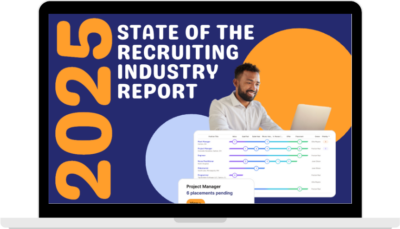(Editor’s note: The information from this article by Top Echelon Recruiting Software has been taken from an Expert Recruiter Coaching Series webinar by Shally Steckerl titled, “Next-Gen Strategies for Referral Growth and AI-Enhanced Recruiting” Click HERE to watch the video of that training webinar for free.)
In a world where AI seems poised to replace human effort, sourcing guru Shally Steckerl offers a powerful counter-narrative: “What if we took over the robots instead of them taking over us?”

His recent webinar, hosted by Top Echelon, wasn’t just a deep dive into ChatGPT and generative AI—it was a masterclass in wielding these tools with strategy and intention. Steckerl, a pioneer in sourcing and founder of The Sourcing Foundation, didn’t just talk about how AI can write content. He showed how AI can become a recruiter’s sourcing sidekick—saving time, increasing productivity, and building better relationships with candidates.
Let’s break down the most important insights from the session and explore how sourcing professionals can truly take over the robots.
The AI Shift in Sourcing: From Threat to Tool
Steckerl opened the webinar with a message that cut through the usual AI hype. “Most people are talking about AI to create marketing content or summarize documents,” he said. “But we’re going to focus on what you can do with AI on your desk right now—today—as a recruiter or sourcer.”
Instead of getting lost in the futuristic promise of generative AI, Steckerl grounds his teaching in practical use cases: scraping websites, enhancing outreach, creating Boolean strings, prescreening candidates, and even preparing for interviews. The goal? Automate the repetitive, tedious tasks and supercharge your sourcing capabilities.
ChatGPT, Bard, and Bing: Which One Is Best?
While many recruiters are paying $20/month for ChatGPT Plus, Steckerl emphasized that most of what he teaches can be done for free with tools like Google Bard or Bing’s AI. “I personally haven’t found the need to pay for ChatGPT,” he said. “I get most of what I need from Bard—and it’s free.”
He explained the major difference: ChatGPT (free version) can’t browse the internet in real-time, whereas Bard can. This becomes critical when you want to scrape websites, analyze current job posts, or evaluate live candidate profiles.
What AI Can—and Can’t—Do
Steckerl offered a balanced view on AI’s strengths and weaknesses. Here’s a summary:
Strengths:
-
Understands natural language (you don’t need to speak ‘tech’).
-
Summarizes large chunks of information quickly.
-
Can remember your past questions in a session to refine results.
-
Provides clear, specific outputs—great for time savings.
Weaknesses:
-
Built-in bias from training data.
-
Limited knowledge base (especially ChatGPT’s free version).
-
Doesn’t always cite sources—making fact-checking difficult.
-
Can be confidently wrong and misleading.
-
Requires fine-tuning to get useful results.
“It can give you the wrong answer, but in a way that sounds very convincing,” Steckerl warned. “That’s why you have to verify everything.”
The Secret Sauce: Crafting Better Prompts
If there’s one core principle Steckerl hammered home, it’s this: success with AI starts with how you ask.
“Everything comes down to the prompt,” he said. “A bad prompt gets you a bad answer. A good prompt opens the door to magic.”
He introduced a six-step prompt framework that every recruiter should memorize:
-
Describe the task using natural language. Don’t be vague. Spell it out like you’re training a new hire.
-
Explain your point of view or persona. Are you a recruiter? A hiring manager? A job seeker?
-
Outline the steps. Give it a workflow: first do this, then that.
-
Give context and constraints. How long should the answer be? What format do you want? Is it for an email or a job board?
-
Specify the goal. What should the output accomplish?
-
Tell it how to format the output. Bullets? Paragraphs? Excel formulas?
Here’s an example of a complete prompt:
“Summarize this job description for a candidate-facing email. Use three bullet points, make it persuasive, and keep it under 250 words.”
Real-Time Use Case #1: Summarizing Job Descriptions
One of Steckerl’s favorite tricks is taking long, clunky job descriptions and turning them into clear, candidate-friendly summaries.
“Sometimes it’s just a laundry list or full of corporate jargon,” he said. “I’ll paste it into Bard and ask for a short, persuasive summary. Then I can use that in an email, a pitch, or even a job ad.”
This simple act saves time and improves communication—a crucial edge in a crowded talent market.
Real-Time Use Case #2: Building Rapport with Candidates
Another smart AI use case? Learning just enough about a candidate’s field to ask intelligent questions.
“If I’m talking to a Python developer, and I’ve never coded in Python, I’ll ask Bard, ‘Explain what a Python developer does like I’m in 8th grade,’” Steckerl shared.
This gives recruiters just enough context to speak confidently and build trust—without pretending to be an expert. Bonus: you can also ask follow-up questions like:
-
What certifications do top candidates have?
-
What does a typical day look like for this role?
-
What distinguishes a great candidate from an average one?
Real-Time Use Case #3: Sourcing Without a Resume or Job Description
Perhaps Steckerl’s most impressive trick is using AI to generate Boolean strings—without even starting from a job post or resume.
Here’s how he does it:
-
Ask: “List the top 10 companies that use [X] technology.”
-
Then: “What are the top 10 job titles at those companies?”
-
Then: “What additional skills do those roles typically require?”
-
Then: “List 20 other companies that hire for those skills, excluding the first 10.”
-
Finally: “Create a Boolean search string using the job titles, skills, and companies.”
This step-by-step refinement builds a powerful search string, ready to drop into LinkedIn, Google, or your ATS.
Real-Time Use Case #4: Personalizing Candidate Outreach
Beyond crafting your pitch, Steckerl uses tools like Magical (a Chrome extension) to personalize outreach based on a candidate’s live profile.
Here’s how it works:
-
Create a base pitch using ChatGPT or Bard.
-
Use Magical to customize that pitch with data from the candidate’s LinkedIn, ATS, or resume page.
-
Send a message that’s both templated and tailored.
“You can make a mass message feel personal,” he said. “That’s where AI shines—helping you do personalization at scale.”
Real-Time Use Case #5: Candidate vs. Job Comparison
Forget just reading a resume and hoping for the best. Steckerl uses AI to do side-by-side comparisons of a candidate’s resume vs. a job description.
“I’ll paste in both, then say: ‘Compare these two in three columns: candidate skills, job requirements, and a summary of the match,’” he explained.
From there, he asks for a 2–3 sentence summary tailored for the hiring manager. This adds context and persuasion to every submittal—making hiring managers far more likely to schedule interviews.
Real-Time Use Case #6: Interview Preparation
You can even use AI to role-play interview scenarios.
Steckerl showed how he preps for interviews by pasting in a job description and asking the AI to become the interviewer. Then, it asks him questions based on the role. You can flip this too—use it to prep interview questions when you’re screening candidates.
“It’s like having a virtual coach,” he said. “It pulls the must-haves from the job and turns them into smart questions.”
Real-Time Use Case #7: Spreadsheet Magic
Recruiters love spreadsheets—but writing formulas? Not so much. That’s where AI shines again.
Steckerl asked ChatGPT to: “Write an Excel formula that splits email addresses in Column A into first name, last name, and company name.”
It gave him multiple solutions—each faster and more accurate than writing one manually. Even regular expressions (regex) were generated on demand. “This saved me hours,” he admitted.
Bonus: Chrome Extensions for Smart Sourcers
At the end of his session, Steckerl shared some of his favorite browser tools that enhance AI functionality:
-
Magical: Personalize messages at scale using candidate page data.
-
ChatGPT via Chrome: Summarize web content instantly.
-
Summarize: Feed it a URL, and it generates a TL;DR.
-
Siri GPT Shortcut (iPhone only): Speak your prompt to Siri, and get the response read back to you. “It’s a hack,” he smiled, “but it works beautifully.”
All of these tools integrate with language models and make sourcing faster and easier.
Final Advice: Don’t Get Discouraged
Steckerl closed the webinar with a piece of wisdom all sourcers should take to heart:
“The first prompt might not work. Try again. The second or third time, it gets better. And when you find a prompt that works? Save it.”
Taking over the robots isn’t about replacing human connection—it’s about freeing yourself to do more of it. AI won’t replace recruiters. But recruiters who use AI effectively? They’ll replace the ones who don’t.
Bonus: Help Others Take Over the Robots, Too
Shally Steckerl isn’t just an expert in sourcing—he’s a giver. He founded The Sourcing Foundation, a 501(c)(3) nonprofit that trains people from underserved communities to enter the recruiting profession. Military spouses, people with disabilities, formerly incarcerated individuals—all are given a path to meaningful, lucrative work.
“Our graduates learn the same sourcing techniques I teach today,” Steckerl said. “And we help them land jobs as sourcers, recruiters, and researchers.”
With AI evolving at warp speed, sourcing professionals have two choices: fear the robots—or take control of them.
With Shally Steckerl’s guidance, you now have the framework, the tools, and the mindset to take over the robots—and make them work for you.







